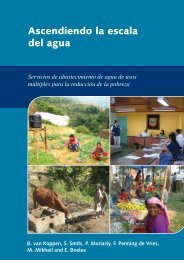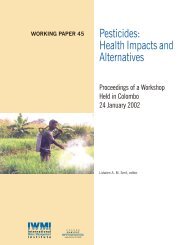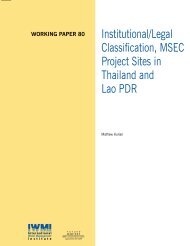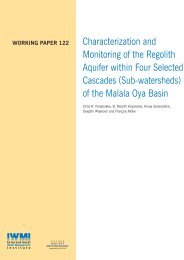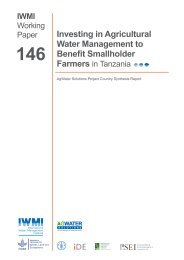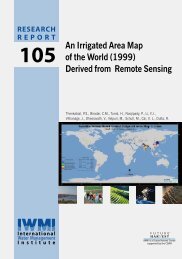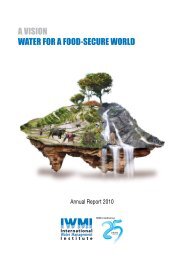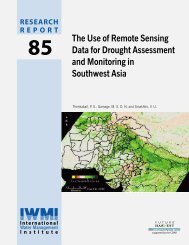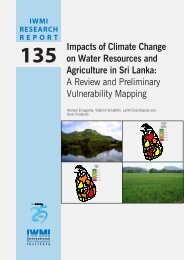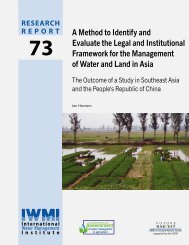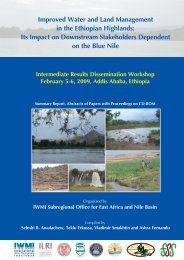12. Monitoring, evaluation and impact assessment - International ...
12. Monitoring, evaluation and impact assessment - International ...
12. Monitoring, evaluation and impact assessment - International ...
Create successful ePaper yourself
Turn your PDF publications into a flip-book with our unique Google optimized e-Paper software.
<br />
183 <br />
<br />
<strong>12.</strong> <strong>Monitoring</strong>, <strong>evaluation</strong> <strong>and</strong> <strong>impact</strong> <strong>assessment</strong> <br />
<br />
Immediate funding is required to establish a CRP5 <strong>Monitoring</strong>, Evaluation <strong>and</strong> Learning (ME&L) <br />
unit to further design <strong>and</strong> implement the CRP5 monitoring, <strong>evaluation</strong> <strong>and</strong> <strong>impact</strong> <strong>assessment</strong> <br />
(ME&IA) system outlined below. The system is, <strong>and</strong> will be, designed in accordance with <br />
Consortium Level <strong>Monitoring</strong> Principles. <br />
<br />
ME&IA in CRP5 has three dimensions: 1) an internal monitoring <strong>and</strong> <strong>evaluation</strong> (M&E) role <br />
associated with project <strong>and</strong> programmatic quality assurance <strong>and</strong> improvement; 2) an external <br />
<strong>impact</strong> <strong>assessment</strong> role one related to providing stakeholders with evidence of outcomes <strong>and</strong> <br />
<strong>impact</strong>s, both potential <strong>and</strong> achieved, resulting from CRP5 work; <strong>and</strong> 3) a commitment to <br />
ensuring accountability to CRP5 stakeholders. There are strong interactions between the three <br />
in terms of learning; being evaluative; <strong>and</strong> working to test, validate <strong>and</strong> revise project, regional, <br />
SRP <strong>and</strong> programmatic theories of change. <br />
<br />
<strong>12.</strong>1. <strong>Monitoring</strong> <strong>and</strong> <strong>evaluation</strong> <br />
<strong>Monitoring</strong> <strong>and</strong> <strong>evaluation</strong> will take place at different levels <strong>and</strong> scales: for the CRP as a whole, <br />
for individual SRPs, for regions, <strong>and</strong> for projects <strong>and</strong> stakeholders. Regular monitoring of <br />
progress <strong>and</strong> achievements, combined with opportunities to synthesize lessons learned <strong>and</strong> <br />
improve the program, form the basis for a flexible <strong>and</strong> adaptive management system. <br />
<br />
We recognize in our theories of change a host of other drivers <strong>and</strong> factors that ultimately <br />
influence desired development outcomes. To better underst<strong>and</strong> causal links <strong>and</strong> relationships, <br />
the ME&IA system will track the emergence of development outcomes to which CRP5 work has <br />
contributed, both expected <strong>and</strong> unexpected. This progress will be monitored through <br />
quantitative – <strong>and</strong>, where appropriate, qualitative – approaches that are transparent <strong>and</strong> <br />
independently verifiable. The actual choice of tools will be made by CRP5 scientists, with <br />
backstopping from the ME&L unit where needed. <br />
<br />
<strong>Monitoring</strong> provides the intelligence needed to evaluate whether CRP5 is working as expected <br />
at its different levels. <strong>Monitoring</strong> <strong>and</strong> <strong>evaluation</strong> does this by seeking to test the logic <strong>and</strong> <br />
assumptions implicit in the theories of change, in part through the use of indicators derived <br />
from changes described in each theory. Learning what is working, <strong>and</strong> what is not, in terms of <br />
leveraging change provides the intelligence required for good adaptive management <strong>and</strong> <br />
supports programmatic improvement. It also tests the extent to which external drivers <strong>and</strong> <br />
other factors influence change processes. It is a social science / action research endeavor in its <br />
own right. It also a practice that ensures commitment to accountability <strong>and</strong>, through its process, <br />
the strengthened capacity <strong>and</strong> empowerment of those directly involved <strong>and</strong> implicated. <br />
<br />
<strong>Monitoring</strong> also seeks to identify unexpected <strong>and</strong> emergent opportunities <strong>and</strong> outcomes, <br />
through the collection of outcome stories that provide plausible evidence of expected change, <br />
both positive <strong>and</strong> negative. The exercise of deriving indicators from program‐ <strong>and</strong> SRP‐level <br />
theories of change will provide the indicators required by the Performance Indicators Matrix <br />
(required by the Fund Council) <strong>and</strong> will be a priority during the CRP5 inception phase. <br />
<br />
<br />
184 <br />
<br />
<strong>Monitoring</strong> of activities <strong>and</strong> outputs <br />
<strong>Monitoring</strong> activities are based on logical frameworks derived from theories of change specified <br />
at different scales (project, region, SRP, program). The theories of change will be developed <br />
collaboratively with partners, with support <strong>and</strong> capacity building from the ME&L unit. Each <br />
partner is responsible for achieving a set of milestones <strong>and</strong> outputs, derived from agreed theory <br />
of change, which will be incorporated into partner agreements, linked to partner payments <strong>and</strong> <br />
evaluated based on 6‐month progress reports by the SRP Manager. The overall quality of the <br />
SRP project outputs will be overseen by the SRP Manager. Budgetary compliance will be <br />
monitored by the lead center. <br />
<br />
We expect that the lead agency for each SRP project will have its own st<strong>and</strong>ardized institute <br />
quality‐management procedures for documenting, reporting, monitoring <strong>and</strong> reviewing <br />
projects. Projects can continue to make use of these for the time being. How these will comply <br />
with st<strong>and</strong>ards for monitoring <strong>and</strong> reviewing to be set by CRP5 will be determined at the start <br />
of the CRP, <strong>and</strong> minimum requirements will be agreed, including agreement on 6‐month <br />
reporting against milestones. <br />
<br />
The monitoring of progress in executing project activities will be the responsibility of each <br />
Project Leader (PL), who is to be appointed by the lead agency of each project <strong>and</strong> activity. The <br />
PLs will produce 6‐month progress <strong>and</strong> financial reports to consolidate progress in terms of <br />
processes, tangible activities <strong>and</strong> outputs. This will ensure close monitoring of progress <strong>and</strong> will <br />
identify the need to change the implementation plans if necessary. Workshops with the project <br />
team <strong>and</strong> stakeholders (partner meetings) at crucial points during the project duration will <br />
provide opportunities for planning, identifying <strong>and</strong> articulating emerging key messages. This <br />
design of the monitoring system will learn from relevant experience from partner organizations, <br />
including the CPWF. <br />
<br />
Evaluation <br />
Evaluation is the periodic analysis of data <strong>and</strong> information, as distinct from monitoring, to learn, <br />
improve <strong>and</strong> assess performance. Types of <strong>evaluation</strong> include exante <strong>and</strong> expost <strong>impact</strong> <br />
<strong>assessment</strong>, external reviews, <strong>and</strong> self‐<strong>evaluation</strong> that takes place during team meetings <strong>and</strong> <br />
workshops. Evaluation will take place at all levels in the CRP. Key operational <strong>and</strong> strategic <br />
lessons learned will be used for future priority setting, project <strong>and</strong> activity design, <strong>and</strong> adaptive <br />
management. <br />
<br />
The ME&L unit will work with CRP5 management to instill an evaluative learning culture in <br />
CRP5, one which supports self‐reflection <strong>and</strong> self‐examination, seeking evidence on which to <br />
make decisions, making time to learn, <strong>and</strong> encouraging experimentation <strong>and</strong> change in others – <br />
including seeking to learn from failure as well as success. <br />
<br />
<strong>12.</strong>2. Outcome <strong>and</strong> <strong>impact</strong> <strong>assessment</strong> <br />
Research is risky. Only a small portion of any research portfolio will lead to widespread uptake <br />
<strong>and</strong> <strong>impact</strong>. Proving attribution, particularly in natural resource management, is difficult <br />
because of the long <strong>and</strong> convoluted pathways linking research to <strong>impact</strong>. Experience shows that <br />
in research carried out in partnership it is more realistic, <strong>and</strong> better for the partnerships <br />
themselves, to seek to demonstrate contribution rather than attribute a percentage of the
<br />
185 <br />
<br />
benefit to a single organization. The ‘contribution not attribution’ principle reflects the core <br />
elements in the design of CRP5. including joint problem definition <strong>and</strong> solving, working in multiinstitutional <strong>and</strong> multi‐disciplinary teams <strong>and</strong> linking up across a wide diversity of partners. <br />
<br />
CRP5 ME&IA system recognizes the inherently unpredictable <strong>and</strong> risky nature of research‐to<strong>impact</strong> pathways. We will seek to minimize the risk in the first place through exante <strong>impact</strong> <br />
<strong>assessment</strong>, priority setting <strong>and</strong> making explicit theories of change at different levels in the <br />
program. The initial research portfolio will be developed based on workshops, e‐consultation <br />
<strong>and</strong> existing <strong>assessment</strong>s of the magnitude of problems. Constructing theory of change will <br />
prioritize what research is conducted where to help tackle the problems. <br />
<br />
To facilitate outcome <strong>and</strong> <strong>impact</strong> <strong>assessment</strong>, monitoring <strong>and</strong> <strong>evaluation</strong> of baseline information <br />
on key indicators will have to be collected <strong>and</strong> agreed upon. It will not be possible to have full <br />
sets of baseline data for all CRP5 activities. Therefore, intelligent choices need to be made to <br />
focus on some key indicators <strong>and</strong> specific sites selected in each region, initially using theories of <br />
change as guidance. Special attention will be paid to monitoring changes in knowledge, attitudes <br />
<strong>and</strong> practice of project stakeholders. We will also collect outcome stories to provide evidence <br />
that change is happening <strong>and</strong> that it happened because of the program, i.e. plausible <br />
contribution. <br />
<br />
The ME&L team will work closely with the gender team in developing gender indicators <strong>and</strong> <br />
integrating a gender <strong>and</strong> diversity approach across the ME&L system. Gender <strong>and</strong> diversity will <br />
be included in theory of change in terms of expected outcomes <strong>and</strong> <strong>impact</strong>s. It will also be <br />
included in the very process of ME&L, including tool design, selection, implementation <strong>and</strong> <br />
sense‐making. <br />
<br />
Ultimately, we will want some indication of development <strong>impact</strong>. The ME&L unit will <br />
commission outcome <strong>and</strong> <strong>impact</strong> <strong>assessment</strong>s, both expost <strong>and</strong> exante, on a proportion of the <br />
research portfolio, using both in‐house <strong>and</strong> external expertise. A few selected <strong>impact</strong> <br />
<strong>assessment</strong> studies will be conducted annually, starting in year 3 of the CRP. Case studies for <br />
<strong>impact</strong> <strong>assessment</strong> will be identified with SRP Managers. In recent years the St<strong>and</strong>ing Panel for <br />
Impact Assessment <strong>and</strong> various other groups <strong>and</strong> programs have provided inputs <strong>and</strong> support <br />
in this area. Support in the development of <strong>impact</strong> <strong>assessment</strong> methods will be sought <br />
whenever required. <br />
<br />
Sentinel sites, presented in the Information SRP, will play a role in this as well. Sentinel site <br />
information will include key socioeconomic, gender <strong>and</strong> equity data <strong>and</strong> information, as well as <br />
key biophysical parameters. While CRP5 <strong>impact</strong> will exp<strong>and</strong> well beyond the sentinel sites, longterm monitoring of change in these locations will allow for detailed underst<strong>and</strong>ing of researchinfluenced innovation processes that will guide uptake strategies in other locations, as well as <br />
providing a basis for rigorous <strong>impact</strong> <strong>assessment</strong>. <br />
<br />
<strong>12.</strong>3. Setting up the ME&L system <br />
The starting point for CRP5 support strategies, including ME&L, are the theories of change <br />
developed at different levels in CRP5. This is because in describing who the projects, SRPs, <br />
basins <strong>and</strong> the Program intend to influence, researchers <strong>and</strong> managers are letting it be known
<br />
what should be monitored, evaluated, as well as where they need help with marketing, <br />
communications <strong>and</strong> uptake. A cross‐functional team will be formed to work with researchers <br />
<strong>and</strong> stakeholders to develop theories of change, taking a ‘learning by doing’ approach to <br />
building necessary capacity. This team will begin holding theory of change workshops in the <br />
inception phase. <br />
<br />
At the same time the ME&L unit will lead a team to develop a MEL&IA strategy for CRP5 to <br />
ensure close monitoring <strong>and</strong> <strong>evaluation</strong> of project results, outcomes <strong>and</strong> <strong>impact</strong>s. The team will <br />
work with the participating CGIAR centers <strong>and</strong> other lead agencies to build on their internal <br />
systems to develop a lean <strong>and</strong> ’least cumbersome’ MEL&IA framework. In the first year, a <br />
workshop with SRP Managers <strong>and</strong> key project leaders will be held to discuss proposed ME&IA <br />
frameworks <strong>and</strong> suggestions for <strong>impact</strong> <strong>assessment</strong> <strong>and</strong> baseline studies. <br />
<br />
The ME&L unit will be led by the CRP5 Management Committee member responsible for M&E <br />
<strong>and</strong> include one full‐time evaluator <strong>and</strong> part‐time ME&L leads from each of the SRPs. The M&E <br />
leads will be responsible for co‐developing the MEL&IA framework while at the same time <br />
building capacity in its use. Experience from the CPWF shows that building a lean ME&L system <br />
for users requires a significant investment in co‐design <strong>and</strong> capacity building. The unit will call <br />
on <strong>and</strong> build a cadre of consultants to be used for training <strong>and</strong> <strong>evaluation</strong> purposes. <br />
<br />
<br />
186




